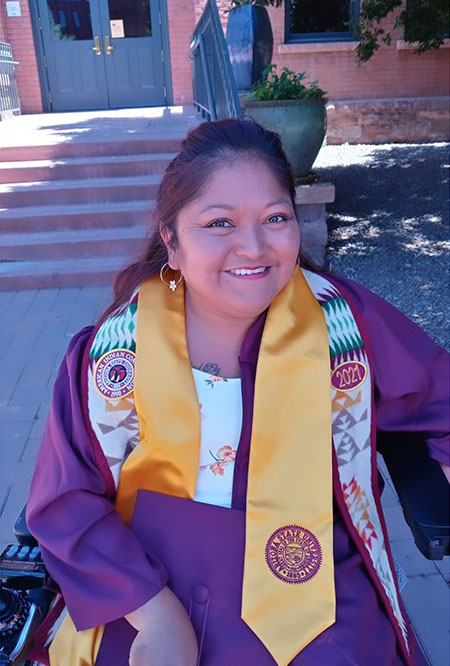Editor's note: This story is part of a series of profiles of notable spring 2021 graduates.
Amber Cook’s parents taught her to advocate for herself — a skill that has served her well while in college. She is graduating from Arizona State University this semester with a degree in art studies from the Herberger Institute for Design and the Arts, with a minor in design studies.
Cook, who is from St. Michaels, on the Navajo reservation, was born with cerebral palsy. She uses a wheelchair, has a slight speech impediment and some limitations in her hands.
“My parents fought to raise me to be as independent as I can be and to have just as much equal opportunity as everyone else,” she said.

Amber Cook is graduating with a degree in art studies and would like a career in architecture, designing accessible housing. Photo courtesy of Amber Cook
Her mother worked for the Arizona Department of Education’s Parent Information Network, a service for families with special-needs children.
“So my mother and I would be a mother-daughter advocate team, doing panels and keynote speeches,” she said.
“Now that I’m an adult, when schools or businesses request my voice or appearance, I do it on my own.”
At ASU, she advocated for herself during her first design studio. After a low grade at the start of her class, she said her ability to complete the work was questioned.
“This was my first time in a design studio and it was their first time having a student with a physical disability. So it was a learning process for all of us,” Cook said.
“I wanted to prove that I am capable, so I put in double the effort and time and finished the class with a 94%.”
Cook, who served as president of the Herberger Institute Student Council, answered some questions from ASU News:
Question: Why did you choose ASU?
Answer: It was the family alma mater. I have two aunts who graduated from ASU.
Q: What was your “aha” moment when you realized you wanted to study the field you majored in?
A: I have always had a passion for art, since I was a kid. Plus, my stepfather was an artist and he was a major influence on my life. Honestly, this is a pit stop along my educational path to earning a master’s of architecture. My goal is to start my own architecture firm, specializing in special accommodations and suitable living and access for people with disabilities.
Q: What’s something you learned at ASU that surprised you or changed your perspective?
A: Pay attention. Ask questions. Seek help if needed. And build relationships.
Q: What advice would you give to an incoming freshman at ASU?
A: My advice would be to break out of your shell and speak up. Nothing will get done and no one will know what you need until you do. Everyone is different and no one is perfect.
Q: What was your favorite spot on campus, whether for studying, meeting friends or just thinking about life?
A: I never really had a certain spot because I was always in motion.
Q: What are your plans after graduation?
A: Take a break, with a semester off to either do an internship or work on the book I’m writing about my life and experiences.
Q: What’s the most important thing you want people to know about you?
A: That I’m still human, despite having a disability. I still have dreams, goals and desires like everyone else, and that I’m living my life for me.
Q: If someone gave you $40 million to solve one problem on our planet, what would you tackle?
A: I think it would have to do with going green, as in revitalization of the natural environment and our ecosystem. I’m Native American, so we’re taught to care about the Earth and the essentials for survival. So more planting, which equals more fresh food, less health problems, cleaner air, more precipitation and more animals.
More Arts, humanities and education

ASU workshop trains educators, professionals from marginalized communities in disaster science
As devastating as hurricanes can be to anyone caught in their paths, they strike marginalized communities even harder.To address this issue, a fund named for a former Arizona State University…

ASU’s Humanities Institute announces 2024 book award winner
Arizona State University’s Humanities Institute (HI) has announced “The Long Land War: The Global Struggle for Occupancy Rights” (Yale University Press, 2022) by Jo Guldi as the 2024…

Retired admiral who spent decades in public service pursuing a degree in social work at ASU
Editor’s note: This story is part of coverage of ASU’s annual Salute to Service.Cari Thomas wore the uniform of the U.S. Coast Guard for 36 years, protecting and saving lives, serving on ships and…
